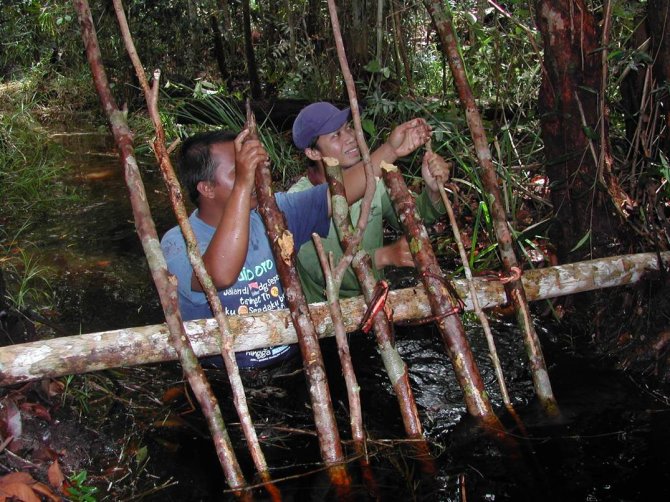
In the spotlight
Conservation of Indonesia's peatland is in everyone's interest
Wageningen University & Research is cooperating with parties including Indonesian partners on the conservation of Indonesia's peatland. This is of importance to both the conservation of biodiversity and the quality of the climate, as peatland that is destroyed by fire or oxidation makes a large contribution to global CO2 emissions.
What does tropical peatland look like? Tropical peatland differs from Dutch peatland. Peatland is formed when the rate of wetland vegetation production exceeds the rate of decomposition. Dutch peatland is usually formed from plants including moss, reed or sedge. 'Tropical peatland is formed from trees, as a result of which it is much coarser and contains a large amount of wood and root residues,' Henk Wösten, soil scientist at Wageningen Environmental Research (Alterra) explains. 'This peatland is also much more porous and permeable.'
CO2 capture
In wet conditions tropical peatland can accumulate at a rate of a millimetre a year, due to the trees growing in the peatland, and form a layer of a depth of as much as 20 metres. 'This peatland captures large amounts of CO2. This is the reason why the Kyoto Protocols also devote attention to the conservation of this function.'
Oil palm and acacia
Water table levels of half a metre and lower under the surface of tropical peatland initiate decomposition processes in the upper layer. These processes consume oxygen and produce CO2. This decomposition also results in shrinkage. The water table level of peatland used to cultivate oil palm or acacia (which is often used in the paper industry) needs to be lowered by drainage to allow the trees to grow. 'Oil palm trees thrive when the water table is 80 centimetres below the surface,' Henk Wösten explains. This drainage results in year-round subsidence amounting to about 8 centimetres a year at this water table level of 80 centimetres. 'About 60 per cent of this subsidence is due to oxidation that results in CO2 emissions and the remaining 40 per cent is due to permanent dehydration that results in the compaction of the layer to form peat.' A one centimetre lowering of the water table results in CO2 emissions of about 0.9 tonne per hectare per annum, equivalent to the emissions of a new car in the Netherlands that travels 9,000 kilometres a year. The reason why peatland is often used for palm and acacia plantations is that peatland is regarded as waste land without title.

Every year the drainage of peatland results in decomposition and, consequently, CO2 emissions and subsidence.
Peatland fires
Drainage also results in the dehydration of the top layer that increases its flammability. Large-scale peatland fires break out in Indonesia every year. The cause of these fires is not usually known: they can be started deliberately, but can also be caused by, for example, a lightning strike or a discarded cigarette end. Henk Wösten says that 'Once peatland catches fire it is extremely difficult to extinguish. These fires creep underground.' Peatland fires also cause a lot of smoke nuisance – extending to neighbouring countries – and also release large quantities of CO2. These fires also threaten the habitat of rare flora and fauna including orangutans.
Protection
Indonesia has been making increased efforts in recent years to conserve the peatland by introducing legislation, regulations and monitoring programmes. Peatland with a thickness of more than three metres now enjoys statutory protection and a moratorium has been imposed on plantations on peatland, as palm trees can also grow on mineral soil.
Water logging
The accelerated decomposition of peatland and peatland fires can be prevented by water logging. Wageningen University & Research studies are making two contributions to this protection. Firstly, scientists in Indonesia are working on the restoration of peatland with water logging. This work includes a project with the World Wildlife Fund, Sriwijaya University and the German Remote Sensing Solutions organisation that encompasses the restoration of 100 thousand hectares on the island of Sumatra.

'Drainage channels have been laid out in these areas that are sometimes only a metre wide but can be as much as 10 kilometres long. They are also used to transport wood out of the forest. We use local materials to dam the channels and re-saturate the peat. This stops the decomposition of the peatland and even gives the ground an opportunity to capture CO2 again. For this reason, every euro invested in water logging is as least as effective as our efforts to conserve energy in the Netherlands. As climate change does not end at national borders, making a contribution to the reduction of Indonesian emissions is also in our interest.'
Segregation of functions
Research has also made clear that what is referred to as an ‘independent basin approach’ is of great importance. 'The entire peatland area between large watercourses needs to be protected. At present, this protection is often limited to the basin's central peatland area that is surrounded by plantations that require the lower water table. This greatly complicates the protection of the central peatland area,' Henk Wösten explains. 'It's then preferable to segregate the functions: you either drain the entire area for agricultural purposes or you protect the entire area.'